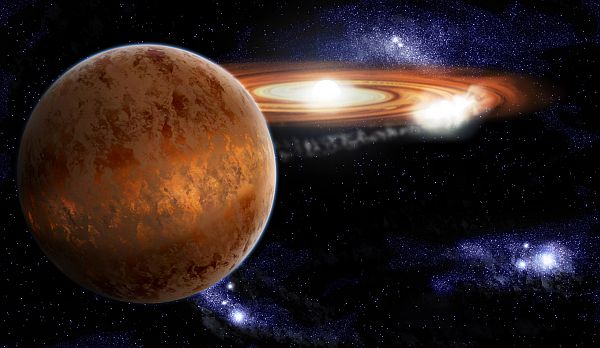WHT+ULTRACAM
A long-standing and unverified prediction of binary star evolution theory is the existence of a population of white dwarfs accreting from substellar donor stars. Such systems ought to be common, but the difficulty of finding them, combined with the challenge of detecting the donor against the light from accretion, means that no donor star to date has a measured mass below the hydrogen burning limit.
A binary star system in which a white dwarf accretes material from a companion is called a cataclysmic variable (CV). Every kilogram of material that falls onto the white dwarf gains the energy equivalent of a few kilotons of TNT. Much of this energy is released as ultraviolet or x-ray radiation. Many CVs have been identified from this highly variable, short-wavelength light produced by rapid mass transfer onto the white dwarf. However, most CVs should have evolved through this violent phase to become a "dead CV" with a low-mass companion that can support only weak mass transfer. Extensive efforts to confirm this long-standing prediction have failed to identify any CVs that have clearly survived the rapid mass transfer phase of their evolution. Now, a team of astronomers report in Science (see reference below) the unambiguous detection of a dead CV from a direct mass measurement of the low-mass companion in the CV SDSS 103533.03+055158.4 (SDSS 1035 for short).
A typical CV is smaller than the Sun, so there is a good chance that the orientation of the binary is such that the companion eclipses the white dwarf once every orbit as seen from Earth.
This will lead to an apparent dimming of the CV every orbit during the few minutes that the companion blocks the light from the white dwarf. SDSS 1035 is an eclipsing CV, so there is a wealth of information to be gleaned from the changes in
brightness during the eclipse. These show, for example, that the mass transferred from the low-mass companion forms a disc around the white dwarf with a bright spot on its outer edge due to the inflowing material.
 |
Figure 1. Artist's impression of SDSS 1035+0551. The hot white dwarf is the same
size as the Earth, yet weighs the same as our Sun. The brown dwarf is
about the same size as Jupiter, but much more massive. The gravity of the
white dwarf pulls gas from the brown dwarf; this gas spirals down onto the
surface of the white dwarf, like water down a plughole, forming an
"accretion disc" of hot gas around the white dwarf. Where the falling gas
from the brown dwarf hits the accretion disc, it creates a hot spot. The
position of this hot spot depends on the masses of the two stars. The
authors precisely timed when the white dwarf and hot spot were eclipsed by
the brown dwarf. This allowed them to measure the location of the hot
spot, and infer the masses of the two stars. Credit: Stuart Littlefair/Science.
|
The orbital period of SDSS 1035 is only 82 min, so small features such as the white dwarf are eclipsed in less than a minute. To accurately measure these rapid changes in brightness in such a faint star, Littlefair et al.
used the William Herschel Telescope and ULTRACAM, an instrument they designed that uses CCDs to measure the brightness of CVs and other rapidly varying stars. The data quality is impressive and leads to a mass for the companion
accurate to about 4%. This is good enough to show convincingly that they are observing a genuine dead CV because the companion is well below the limit of 0.072 solar masses
which a star cannot sustain nuclear reactions in its core. Objects that are born with masses below this limit are known as brown dwarfs.
References:
- S. P. Littlefair, V. S. Dhillon, T. R. Marsh, Boris T. Gänsicke,
John Southwort, C. A. Watson, 2006, "A Brown Dwarf Mass Donor in an Accreting Binary", Science, 314, 1578.
- Pierre F. L. Maxted, 2006, "A Ghostly Star Revealed in Silhouette", Science, 314, 1550.
- "Cataclysmic Cannibals in the Sky", Science Press Release, 7 December 2006.
|

